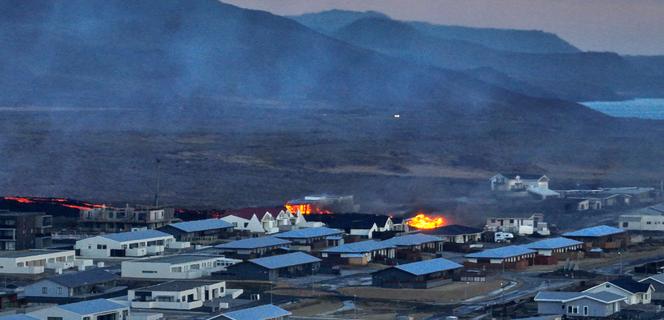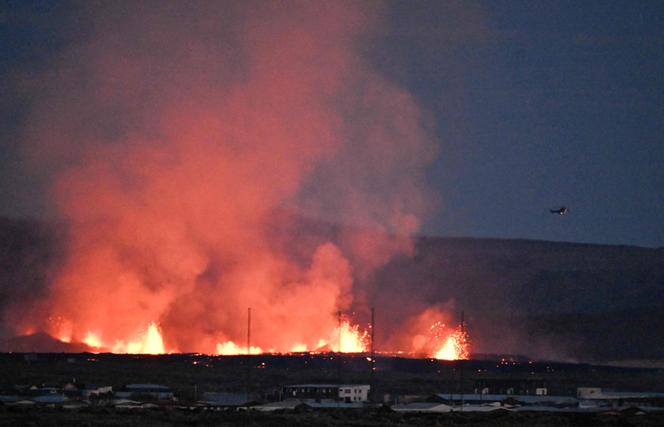


Lava flowing from a volcano that erupted on Sunday, January 14, near the Icelandic fishing port of Grindavik has engulfed at least three homes just hours after villagers were evacuated to safety, authorities said. It was the North Atlantic nation's fifth volcanic eruption in under three years. The most recent occurred just weeks ago on December 18 in the same region, southwest of the capital Reykjavik. At least three houses were engulfed in fire as glowing orange lava flowed into the edge of the town of Grindavik, live images broadcast by public television RUV showed.
Most of the 4,000-strong population of Grindavik had been evacuated as a precaution on November 11 after scientists said a magma dyke was shifting beneath them. At the time, a series of small earthquakes – sometimes hundreds per day – had created large cracks in roads, homes and buildings.
On Sunday, a first eruption began at 8:00 am (0800 GMT) when a crack opened in the ground around 450 meters (500 yards) from the town. At 1845 GMT, the Icelandic Metereological Office (IMO) said that the fissure measured around 900 meters long, and crossed over the main road to Grindavik.


A second fissure then opened around midday on the edge of town, with that lava engulfing the homes. It measured around 100 meters by evening, IMO said. Jets of orange lava and plumes of smoke spewed into the sky from the two cracks throughout the day. The eruption knocked out electricity and hot and cold water in Grindavik, authorities said, but airline flights were not affected.
At a press conference, Prime Minister Katrin Jakobsdottir called Sunday a "black day today for Grindavik and ... for all of Iceland. But the sun will come up again." The head of Iceland's Civil Protection and Emergency Management, Vidir Reynisson, said the eruption was "the most serious threat" posed by a volcanic eruption in Iceland since January 1973. Back then, a fissure erupted just 150 meters from the town centre on Heimaey in the Vestmann Islands, surprising locals at dawn. A third of homes were destroyed and the 5,300 residents were evacuated. One person died.
In a rare address to the nation, Iceland's President Gudni Johannesson said he "hoped the situation would calm down, but anything can happen". Amid the uncertainty facing the town, he urged Icelanders to "stand together and have compassion for those who cannot be in their homes."
Shortly after the December 18 eruption, Grindavik residents were allowed to return for brief periods. They were authorised to regain their homes permanently on December 23 but only a few dozen chose to do so.
Late on Saturday, authorities had ordered an emergency evacuation to be completed by Monday due to growing seismic activity and its impact on the large cracks already present in the town.
On Wednesday, a 51-year-old Icelandic workman who was repairing a crack in a residential garden disappeared when the ground suddenly gave way beneath him. He fell more than 30 meters. The intensive search to find him was called off on Friday because the area was too dangerous. Authorities accelerated the evacuation order overnight when seismic activity intensified.
Officials are keeping a close eye on the nearby Svartsengi geothermal plant, which provides electricity and water to the 30,000 residents of the Reykjanes peninsula. Workmen have been building a wall to protect the facility since November.
Until March 2021, the Reykjanes peninsula had not experienced an eruption for eight centuries. Fresh eruptions occurred in August 2022, and July and December 2023, leading volcanologists to say it was probably the start of a new era of activity in the region. Four days after the December 18 eruption, authorities said volcanic activity had stopped but they could not declare the eruption over because there was still a possibility of underground lava flow.
At a press conference, Prime Minister Katrin Jakobsdottir called Sunday a "black day today for Grindavik and ... for all of Iceland. But the sun will come up again." The head of Iceland's Civil Protection and Emergency Management, Vidir Reynisson, said the eruption was "the most serious threat" posed by a volcanic eruption in the ocean floor separating the Eurasian and North American tectonic plates.
